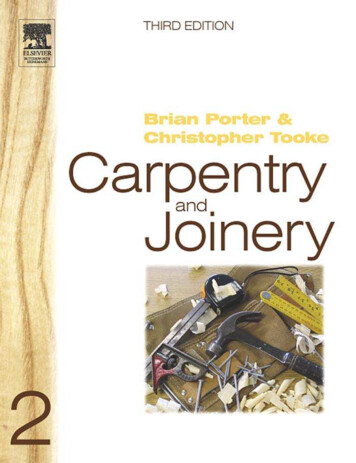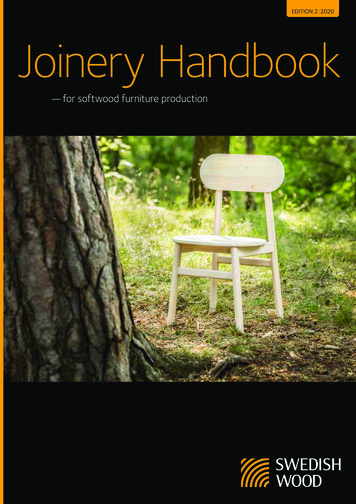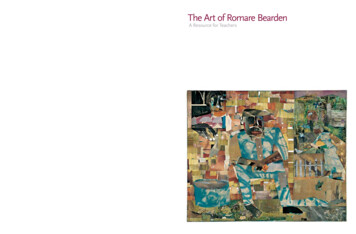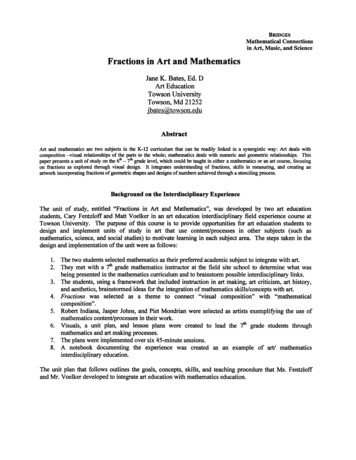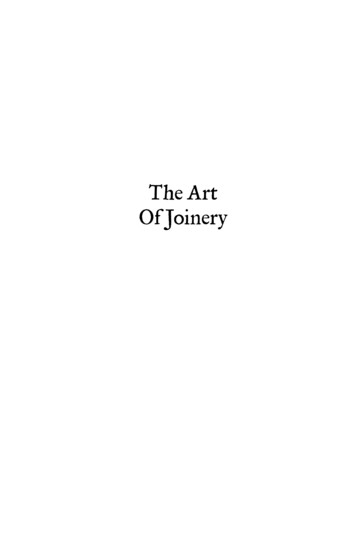
Transcription
The ArtOf Joinery
Published by Lost Art Press LLC in 201326 Greenbriar Ave., Fort Mitchell, KY 41017, USAWeb: http://lostartpress.comTitle: The Art of JoineryAuthors: Joseph Moxon, commentary by Christopher SchwarzPublisher: Christopher SchwarzDistribution: John HoffmanEditor: Megan FitzpatrickDesign & Layout: Linda WattsIndex: Suzanne EllisonCover: Christopher SchwarzCopyright 2013 by Lost Art Press LLCISBN: 978-0-9850777-7-8ALL RIGHTS RESERVEDNo part of this book may be reproduced in any form or byany electronic or mechanical means including informationstorage and retrieval systems without permission in writingfrom the publisher, except by a reviewer, who may quotebrief passages in a review.Printed and bound in the United States of America.
The Art Of JoineryBy Joseph Moxonwith commentary by Christopher SchwarzzåSecond Edition
ivTable of ContentsIntroduction to the Second Edition.vThe Art of Joinery, Edited with Commentary. 1The Plates.93The Art of Joinery, Unedited. 98Select Plates from André Félibien.141Index. 153
vIntroduction to the Second EditionJoseph Moxon’s “Mechanick Exercises” is more than just a curiosity for historians of the craft of woodworking. The woodworking tools that Moxondescribes and the processes he explains have remained remarkably unchangedduring the intervening centuries. To be sure, we might now use fancier materials for some of our tools – investment-cast bronze, ductile iron, A2 steel.But a fore plane is still a fore plane, and it is still used in the same mannerto make rough boards into smooth ones.In fact, I consider Moxon to be an excellent introduction to many handtool aspects of woodworking. That is, if you can decipher his 17th-centuryEnglish spellings and sentence structure that are odd to our 21st-century eyes.The “Mechanick Exercises or the Doctrine of Handy-Works” was originally published in serial form beginning in 1678 in England. Moxon was aprinter, cartographer, globe maker and maker of mathematical instruments.In addition to the art of joinery, the “Mechanick Exercises” included pamphlets on blacksmithing, house carpentry, bricklaying and drawing a sundial.Moxon (1627-1691) is perhaps best known for his treatise on the “WholeArt of Printing,” which features a long biography of his dealings, mostly asthey relate to the world of printing. The version of “The Art of Joinery” inthis book is adapted from the 1703 edition of “Mechanick Exercises,” whichwas the first complete edition, and it has been reprinted by both the EarlyAmerican Industries Association and The Astragal Press. Both of those editions are currently out of print and unavailable. The plates in this editionappear courtesy of the Early American Industries Association.So I took the Astragal version and had the original text entered into acomputer (the text is in the public domain). I then adapted Moxon’s workinto the text you have here. This slim book is an attempt to acquaint themodern woodworker with the earliest English-language text on woodworking, to update its language and spellings just enough so they’re not distracting, and to provide some modern commentary and illustrations that willhelp amplify some of the processes Moxon describes.It’s important to mention that I am not an academic, and this bookis not an attempt to provide a proper and scholarly annotated version ofMoxon, a form of writing that many of us will remember from our days of
vireading William Shakespeare in middle school. Instead, this book is a working woodworker’s attempt to illustrate and explain Moxon’s groundbreakingwork in a way that you (who are also a woodworker, I hope) might be ableto learn something useful for your own workshop practice.As a result, I shortened Moxon’s run-on sentences without (I hope) erasing their meaning. Usually this was accomplished not by removing words,but by adding semicolons or periods. I’ve added photographs and text toattempt to illustrate Moxon’s words, so you can actually see a “dawk” or the“risings that bear against the tongue” and know instantly that they are “agouge in the work” or “a high spot that needs to be removed.”I’ve also added a few words and phrases throughout Moxon’s text. Mywords are in square brackets and Moxon’s asides are in parentheses. Aftereach of Moxon’s 37 sections (actually 38, but more on that later), I haveincluded my own commentary in sections titled “Analysis.”Since I published the first edition of this book in 2008, my research intoearly woodworking has continued, and so many of the analysis sections havebeen enlarged or revised, especially in the case of the workbench.One of the criticisms of my first edition was that I didn’t include thepure 17th-century text in the book so that the reader could analyze theoriginal. And so we have reprinted the original text at the end of this volumewith all the long “s” characters, italics and punctuation. We reset the text ina typeface named “Fell,” which is adapted from early typefaces but has been“cleaned up” for lack of a better word. In essence, the makers of Fell soughtonly to correct damage that had occurred to the individual pieces of type asthey were set and reset in a press.Finally, at the end of the book, I have added an appendix: A selectionof plates from André Félibien’s “Principes de L’architecture” (1676), so youcan see the similarities (and differences and omissions) between these twoimportant works.What you won’t find anywhere in Moxon (or this book) are the socalled secrets to the craft that allow you to make a highboy in a week orsharpen your handplanes to razor sharpness with primitive and coarse abrasive technology. Those things aren’t in Moxon.Instead, what you’ll find are the things you would find if you walkedinto a joiner’s shop in 17th-century England and watched the joiners at workfor a few weeks and got to ask them some questions over a small beer (justremember not to dump your drink in the glue pot).
viiMoxon’s unusual workbench. The face vise is typically on the left endof the bench for right-handers (and Moxon wrote for right-handers). What gives?Read on.But that information is more than useful enough and is surprisinglyfresh in the 21st century. That’s because so much of the modern way ofteaching woodworking is based on machine work or on idiosyncratic waysof working with hand tools that have little to do with proper historical tradepractice.Another important thing to note: Moxon wasn’t a woodworker, blacksmith or a turner (as far as we know), but his accounts of early workshoppractice are what we have as a beginning point. And though I will point outa few modern “improvements” that have arrived in the last 330 years (metalbodied planes, plow planes with several irons), this book is where how-towoodworking began. – Christopher Schwarz
1z The Art of JOINERY. åDefinition.Joinery is an art manual, whereby several pieces of wood are so fitted andjoined together by straight line, squares, miters or any bevel, that theyshall seem one entire piece.Explanation.By straight lines I mean that which in joiner’s language is called a joint.That is, two pieces of wood are shot {that is, planed} or else they arepared; that is, the irregularities that hinder the closing of the two piecesare cut off with a paring chisel. They are shot or pared {as I said} toexactly straight, [so] that when they are set upon one another, light shallnot be discerned betwixt them. This they call shooting of a joint or paring to a joint, because these two pieces are with glue commonly joinedtogether, either to make a board broad enough for their purpose, or toclamp one piece of wood to the end of another piece of wood to keep itfrom casting or warping.By squares, I mean the making of frames, for door cases or such likewhich is the framing of two pieces of wood, so as the four angles of theframe may comply with the square marked D [in Plate 4].By miters are meant the joining of two pieces of wood, so as the jointmakes half a square, and does comply with the miter square marked E [inPlate 4]. By bevel is meant any other angle: As frames that may be madeof [a] pentagon, hexagon, octagon [and other] figures.S.1. The Names of joiners tools described in Plate 4.A. A Workbench. b. The hook in it, to lay boards or other stuff flat against,whilst [you] are trying or planing [them]. c. The bench screw {on its hither[left] side} to screw boards in while the edges of them are planed or shot.
2The Art of JoineryAnd then the other edge of the board is set upon a pin or pins {if the boardbe so long as to reach the other leg} put into the holes marked “aaaa”down the legs of the bench. [These] pins may be removed into the higheror lower holes as the breadth of the board shall require. So then, thebench screw keeps the board close to the edge of the bench, and the pins inthe leg keep it to its height, that it may stand steady whilst the other edgeis worked upon. For in the shooting of a joint, if the board keeps not itsexact position, but shakes or trembles under the plane, your joint will veryhardly be truly straight. d. The holdfast, let pretty loose into round holesmarked “bbbbbb,” in the bench. Its office is to keep the work fast upon thebench whilst you either saw, tenon, mortise, or sometimes plane upon it.It performs this office with the knock of a hammer or mallet upon thehead of it. [Here’s how it functions]: [T]he beak of it being made crookeddownwards [with] the end of the beak falling upon the flat of the bench,keeps the head of the holdfast above the flat of the bench. The hole inthe bench [that] the shank is let into [is] bored straight down and [is] wideenough to let the holdfast play. The head of the holdfast being knocked,the point of the beak throws the shank aslope in the hole in the bench andpresses its backside hard against the edge of the hole on the upper surfacesof the bench, and its fore-side hard against the opposite side of the undersurfaces of the bench. And so [because of] the point of the beak, the shankof the holdfast is wedged between the upper edge and its opposite edgeof the round hole in the bench. Sometimes a double screw is fixed to theside of the bench as at g; or sometimes its farther cheek [rear jaw] is laidon edge upon the flat [top] of the bench and fastened with a holdfast, or,sometimes, two [holdfasts] on the bench. c A mallet.z AnalysisLet’s talk about Moxon’s workbench because it seems a confusing andmuddled drawing. It certainly looks like it was borrowed from André Félibien’s “Principes de L’architecture” (1676) and then modified with the addition of an unusual double-screw vise on the right side of the bench.Moxon’s entire book is written for right-handers, yet he shows a benchthat seems more suited for a left-hander at first glance. (He also later showsa plow plane drawn in reverse, so it might be easy to think that this bench is
Joseph Moxon 3moxon’s workbench. From plate 4.also drawn in reverse and that this is typical and no big deal for the period.)However, I think that when you look closely at the illustration and the texttogether, things start to make sense.First, let’s discuss Moxon’s “bench screw.” It is a single screw on the leftside of the bench (look close, it’s in shadow). This screw appears to pierce atypical French crochet or “hook” attached to the front edge of the benchtop.This vise works much like a small shoulder vise, typical on modern Scandinavian workbenches. The screw presses the work against the front edge ofthe benchtop. If the board is long and/or wide, the bottom edge rests on pinsinserted into holes in the legs.While that seems straightforward – once you decipher the murky drawing – the so-called “double screw” is more vexing. Here is Moxon’s original text:Sometimes a double Screw is fixed to the ſide of the Bench, as at g; orſometimes its farther Cheek is laid an edge upon the flat of the Bench andfaſtned with a Hold-Faſt, or, ſometimes, two on the Bench.What is confusing about the text is how the double screw is attached tothe front edge of the bench, as shown in the drawing. To do this as Moxonshows you likely would need two tapped holes in the benchtop, a feature Ihave seen on some early workbenches. But installing this “double Screw”into the bench while the rear jaw was still attached to the front jaw wouldbe cumbersome (the two jaws would lock the screws). First removing the rearjaw would make the vise simple to install in the benchtop. (This sort of vise
4The Art of JoineryMetal Moxon. Several manufacturers now make double-screw vises withwood or metal screws. If you have a tap and threadbox, these vises are easy tomake yourself.is shown in a detail drawing in A.-J. Roubo’s “L’Art du menuisier,” whichappears 100 years after Moxon.) Yet Moxon shows both jaws in the plate.What is more straightforward about Moxon’s discussion of the doublescrew is how it sometimes sits on the benchtop and is sometimes securedwith a holdfast or two. Woodworking researchers Jennie Alexander and PeterFollansbee have long used a small double-screw on the bench much like amodern handscrew clamp. It holds work to be tenoned, or to be mouldedor planed on edge (when the work is pushed against a metal bench hook orstop). Several years ago I began using this double-screw as a vise for dovetailing by fixing the rear jaw to the benchtop with holdfasts, just as Moxonadvised. It works brilliantly.Other aspects of the Moxon bench are typical of what you would find onan early workbench in a somewhat-French style. There is a metal planing stopemerging from the benchtop. Moxon calls this a bench hook. And though itindeed has a hook-like shape, the modern woodworker wouldn’t call it a benchhook. That term is reserved for a wooden accessory used for handsawing.These metal-made planing stops have become rare in modern shops.While one manufacturer still makes some in aluminum (which aren’t worthfooling with), most woodworkers fashion their planing stops from wood. There
Joseph Moxon 5are two obvious downsides to the metal stops: They will damage your tools ifthey strike the metal stop, and the stops will mark the end grain of your work.Those marks aren’t a big deal if you build 17th-century furniture where thistool mark is found, or 18th-century furniture where the end grain is coveredby moulding. But if you like exposed joinery, a metal stop can be trouble.I’ve used a couple variants of metal stops: A beautiful one made by ablacksmith and a serviceable one made by a second blacksmith who fashioned it out of a railroad spike. I couldn’t much see the advantage of a metalstop compared to a wooden stop until I sharpened the teeth with a file. Bothof them seemed to work fine when dealing with stock that is less than 6"wide. Both of them were tricky to use with wider stock.Some early versions of this workbench accessory are actually made usingnails that are driven through the wooden planing stop at a slight angle – soonly the tips of the nails rise above the benchtop, not the heads of the nails.These stops can have a lot of bite and hold your work in place.And then there are the holdfasts. Moxon’s description of the holdfastsis excellent. Clearly, this little metal wedge with a beak was just as curiousto observers in the 17th century as it is today. The earliest image I have of aholdfast is from the 16th century in a painting titled “Le Raboteur” by theItalian artist Annibale Carracci (1560-1609). I would not be surprised if theholdfast is even older.S.2. BBBBBBB Planes of several sorts: as,B1. A. Fore planea. The tote. b. The mouth. c. The wedge. d. The iron. e. The sole. f. Thefore-end g. The britch. f g h The stock. All together a plane. It is calledthe fore plane because it is used before you come to work either withthe smooth plane or with the jointer. The edge of its iron is not groundstraight, as the smooth plane and the jointer are, but rises with a convexarch in the middle of it; for its [ job is] to prepare the stuff for either thesmoothing plane or the jointer. Workmen set the edge of it ranker thanthe edge either of the smoothing plane or the jointer. And should theiron of the plane be ground to a straight edge, and it be set ever so littleranker on one end of the edge than on the other, the ranker end would{bearing as then upon a point} in working, dig gutters on the surface ofthe stuff. But this iron {being ground to a convex arch} though it should
6The Art of Joinerybe set a little ranker on one end of its edge than on the other, would notmake gutters on the surface of the stuff, but {at the most} little dawks[hollows] on the stuff, and that more or less, according [to how] theplane is ground, more or less arching. Nor is it the office of this plane tosmooth the stuff, but only {as I said} to prepare it. That is, to take off theirregular risings, whether on the sides or in the middle. And therefore itis set somewhat ranker, that it may take the irregularities [more quickly]off the stuff [so] that the smoothing plane or the jointer may afterwardsthe easier work it try [flat]. The manner of trying shall be taught when Icome to [discuss] the use of the rule.You must note, that as I told you in smithing {Num. I. page 14, 15, 16}that it was the office of the coarse-toothed file to take off the prominentirregularities the hammer made in the forging, and that you were not tofile them more away than you need. So the same caution is to be given youin the using of this fore plane in joinery, for the reason there alleged insmithing, whether, to avoid repetition, I refer you. Only with this consideration, that in smithing, iron or steel was the matter wrought upon, andthere a coarse file the tool; but now wood is the matter, and a coarse, orfore plane, the tool.z AnalysisWhen it comes to the handplane illustrations in Moxon, I wouldn’t relyon them as being accurate representations of typical 17th-century Englishplanes. They show typical French planes. The text, however, is quite useful.Moxon spills more ink on fore planes than he does on any other form. Thesetools are the equivalent of the modern electric surface planer or poweredjointer. The fore plane is the tool that removes a lot of wood in a hurry thanksto its curved iron and the fact that it is set to take quite a bite. And as a planeuser, I find my fore plane to be one of the most useful tools I own. Whetherthe plane is made of wood or iron, the fore plane is able to quickly removewood (it’s almost shocking at first how fast it works). And I have found itis one of the tools that helps a beginning hand-tool user understand that acorrectly set tool makes handwork easy.The term “fore plane” has almost vanished from the modern vocabularyand has been replaced by the term “jack plane,” a word from the carpenter’slexicon. Stanley Works labeled its No. 6 plane a “fore plane,” though the jobs
Joseph Moxon 7Moxon's fore plane . It's shorter than the jointer and longer than a smooth-ing plane.of the fore are easily picked up by Stanley’s No. 5 jack plane. So if you’relooking for a plane that will serve as a fore, buy one that’s 14" to 18" long(wood or metal), grind the iron so it is curved (an 8"-radius curve is typical)and set the mouth wide open to pass thick shavings.In reading Moxon, it’s easy to think that the fore plane is actually whatStanley calls a “scrub plane” – a tool still manufactured today. However, themetal scrub plane is actually a modern version of a wooden European planefor rough work. The scrub is similar to the fore, but the scrub’s sole is bothshorter and narrower, and the iron has an even more pronounced curve.Both tools work and get material out of your way. But I prefer the longersole of the fore plane. The longer sole makes it easier to get the board flat thanwith a scrub, though the extra weight of a fore plane can be tiring.The other important aspect of Moxon’s entry on fore planes is that itdiscusses a philosophy that Moxon developed in his pamphlets on blacksmithing. That is: Use the coarsest tool possible to make the work with thefiner-set tools quick. One stroke with a fore plane saves many strokes witha jointer plane. This is one of the core principles of hand work that is sometimes forgotten today. Many woodworkers are quick to grab their smoothplane when they should be grabbing the fore.S.3 Of setting the ironWhen you set the iron of the fore plane, consider the stuff you are towork upon. That is to say, whether it be hard or soft, or curling, as joinerscall cross-grained stuff. If it be hard or curling, you must not set the ironvery rank because a man’s strength will not cut deep into hard wood. Andif it be not hard wood, but curling or knotty, and the iron is rank-set, youmay indeed work with it until you come to some knot or curl, but thenyou may either tear your stuff, or break the edge of your iron. Thereforeyou may perceive a reason to set the iron fine for curling and knotty stuff.
8The Art of JoineryBut if you ask me how rank your iron ought to be set? I answer, if yourwood be soft, and your stuff free and soft, that is, evenly tempered all theway, you may set the iron to take a shaving off [that is] the thickness of anold coined shilling [likely a Commonwealth shilling, or approximately.0394", or a fat 1/32"] but scarcely thicker. Whereas if your stuff be hardor curling or knotty, you shall scarcely be able to take a shaving off thethickness of an old groat [likely a Charles II groat, which would be .0236"thick, or less than 1/32"]. Therefore you must examine the temper of yourstuff by easy trials [to determine] how the plane will work upon it, and setyour iron accordingly. And observe this as a general rule: That the iron ofthe fore plane is, for the first working with it, to be set as rank as you canmake good work with; and that [is] for speed sake.If your iron be set too rank, knock with a hammer upon the britch[rear] of the stock, and afterwards upon the wedge. For this knockingupon the britch, if you knock hard enough, will raise [retract] the iron alittle and set it fine. If you knock not hard enough, you must knock againuntil the iron does rise. But if you knock too hard, it will raise the iron somuch that its edge will rise above the sole into the mouth of the stock andconsequently not touch the stuff. Therefore you must knock softly at firstuntil, by trials, you find the iron rises to a convenient fineness. But as thisknocking on the britch raises the iron, so it also raises and loosens thewedge. Therefore {as said before}, whenever you knock upon the britch,you must also knock upon the wedge to fasten the iron again.If you have raised the edge of the iron too fine, you must knock softlyupon the head of the iron and then again upon the wedge. And this you maysometimes do several times until you fit your iron to a convenient fineness.When you have occasion to take your iron out of the stock to rub it,that is, to whet [sharpen] it, you may knock pretty smart blows upon thestock, between the mouth and the fore-end [to loosen the wedge and consequently the iron].These ways of setting are used with all other planes, as well as fore planes.In the using of this, and indeed, all other planes, you must begin atthe hinder end of the stuff, [with] the grain of the wood lying along thelength of the bench, and plane forward until you come to the fore-end,
Joseph Moxon 9Shilling shaving . Moxon’s instructions used coinage to explain how thickyour shavings should be. For softer woods, Moxon specified an “old coined shilling.” This shaving is just about that thickness – or .04" thick.unless the stuff [is to be] proved cross-grained in any part of its length.For then you must turn your stuff to plane it the contrary way, so far asit runs cross-grained. And in [any] planing, you must, at once, lean prettyhard upon the plane and also thrust it very hard forwards, not letting theplane totter to or from you-wards, until you have made a stroke the wholelength of the stuff. And this sometimes, if your stuff be long, will requireyour making two or three steps forward before you come to the fore-endof the stuff. But if you do this, you must come back and begin again at thefarther end, by the side of the last planed stroke, and so continue planinguntil the whole upside [surface] of the stuff be planed.And if the stuff be broad that you are to plane upon, and it has warpeda little with the grain [cupped], or be any ways crooked in its breadth, youmust then turn the grain so it is across the workbench, and plane crossgrain. For if your work be hollow in the middle, you must plane both thebearing sides [the high edges] thinner until they are in the same plane asthe middle. Then turn the other side of your work [flip the board over],and working still cross-grained, work away the middle until it is in thesame plane as the sides or edges.
10The Art of JoineryThis way of cross-grained working is, by workmen, called “traversing.”Thus have you, in general, the use of all the other planes. But the useof those planes are designed for other particular purposes. I shall show[them] as they come in order.z AnalysisWooden planes work the same way they did in the 17th century, soMoxon’s description of the process of adjusting one should seem familiar.However, what is interesting (to history dweebs especially) is when he discusses the sort of shavings you should get from a fore plane. Having nodigital dial caliper, Moxon used the thickness of common coins to discussthe thickness of shavings.After consulting with a couple coin collectors of British coinage andmeasuring some examples (which were surprisingly consistent) here’s how tointerpret Moxon’s instructions. For wood that is easy to plane, Moxon recommends a shaving that is an “old coined shilling.” The coin collectors saidthat judging from the time period and language, that Moxon was discussinga Commonwealth shilling. The Commonwealth shillings that weren’t tooworn were about .04" thick, or a fat 1 32".For the harder, curly or knotty woods, Moxon recommends the shaving be the thickness of “old groat” – likely a Charles II groat. That would beOther English planes. Randle Holme’s drawing of a fore and jack planefor the 1688 “The Academy of Armory” look more like English planes to me thanthe Moxon drawings.
Joseph Moxon 11A groat in your throat. For difficult woods, Moxon recommends a shaving that is as thick as an old groat – or .024" thick.about .024" thick – or a bit less than 1 32". Then Moxon gives a rule that isgolden (in my book): Take the thickest shaving you can that will producegood work, which is “for speed sake.”So how do you adjust the plane? Moxon’s explanation is classic. One ofthe few “innovations” in wooden planes since Moxon is the “strike” or “start”button on the top of some wooden planes. This is a small circle of wood thatprotrudes like (surprise) a button between the toe of the tool and the escapement. You strike the button hard to release the iron. Moxon’s instructionstell you to rap the plane there to release the iron. The strike button preventsyou from denting your plane’s body.Moxon’s instruction for applying a plane to the wood are straightforward: Begin at the hinder end (for right-handers, this is the right end). Planeto the fore-end (the left end). Plane the entire length of the board (walking asyou push the plane if necessary). Work the entire length of the board. Comeback, overlap your strokes and repeat.What might be curious for moderns is Moxon’s description of planingwide, crooked or cupped stock. In these cases, Moxon says you should workdirectly across the grain – what he calls traversing. This strategy works welland is typically under-utilized by modern woodworkers. Traversing flattenshigh spots with little tear-out. When you plane across the grain, the longfibers that make up the wood grain are sliced across by the plane’s iron. It’s
12The Art of JoineryThe cup is up. Traversing is most effective when you are working the cuppedface of the board. The plane’s sole rides the high spots and the iron cuts themback until you hit the low spots.Make a cup without a lathe . Plane out the middle by working with thegrain. Then you’ve made a cup. Now plane across the grain to remove the cup.
Joseph Moxon 13like a crosscut with a plane instead of a rip. Traversing is easy work – youcan take a big bite when you work across the grain. It doesn’t leave a prettysurface (think: wooly worm), but it is one of the most powerful fore planetechniques I’ve found.My personal experience with traversing has been that it works best onthe cupped face of the board because you have two high spots touching theplane’s sole.When you work the face that is bowed, you tend to just copy that bowwhen you are traversing. So what do you do? Moxon says to plane out themiddle first. I do this using strokes with the grain until I reach the finalthickness of my board. This creates a cupped board. Then I traverse acrossthe cup. When my iron just nicks the bottom of the cup, I stop. I’m done.That’s not the gospel according to Joe, however.S.4. Of the Jointer. B. 2.The jointer is made somewhat longer than the fore plane and has its soleperfectly straight from end to end. Its office is to follow the fore planeand to shoot an edge perfectly straight, and not only an edge, but also aboard of any thickness; especially when a joint is to be shet [shot]. Therefore the hand must be carried along the whole length with an equal bearing weight, and [al]so exactly even and upright to the edges of the board,[so] that neither side of the plane inclines either inward or outwards,but that the whole breadth be exactly square on both its sides. Supposing its sides straight, [then] so will two edges of two boards, when thusshot, lie s
phlets on blacksmithing, house carpentry, bricklaying and drawing a sundial. Moxon (1627-1691) is perhaps best known for his treatise on the “Whole Art of Printing,” which features a long biography of his dealings, mostly
